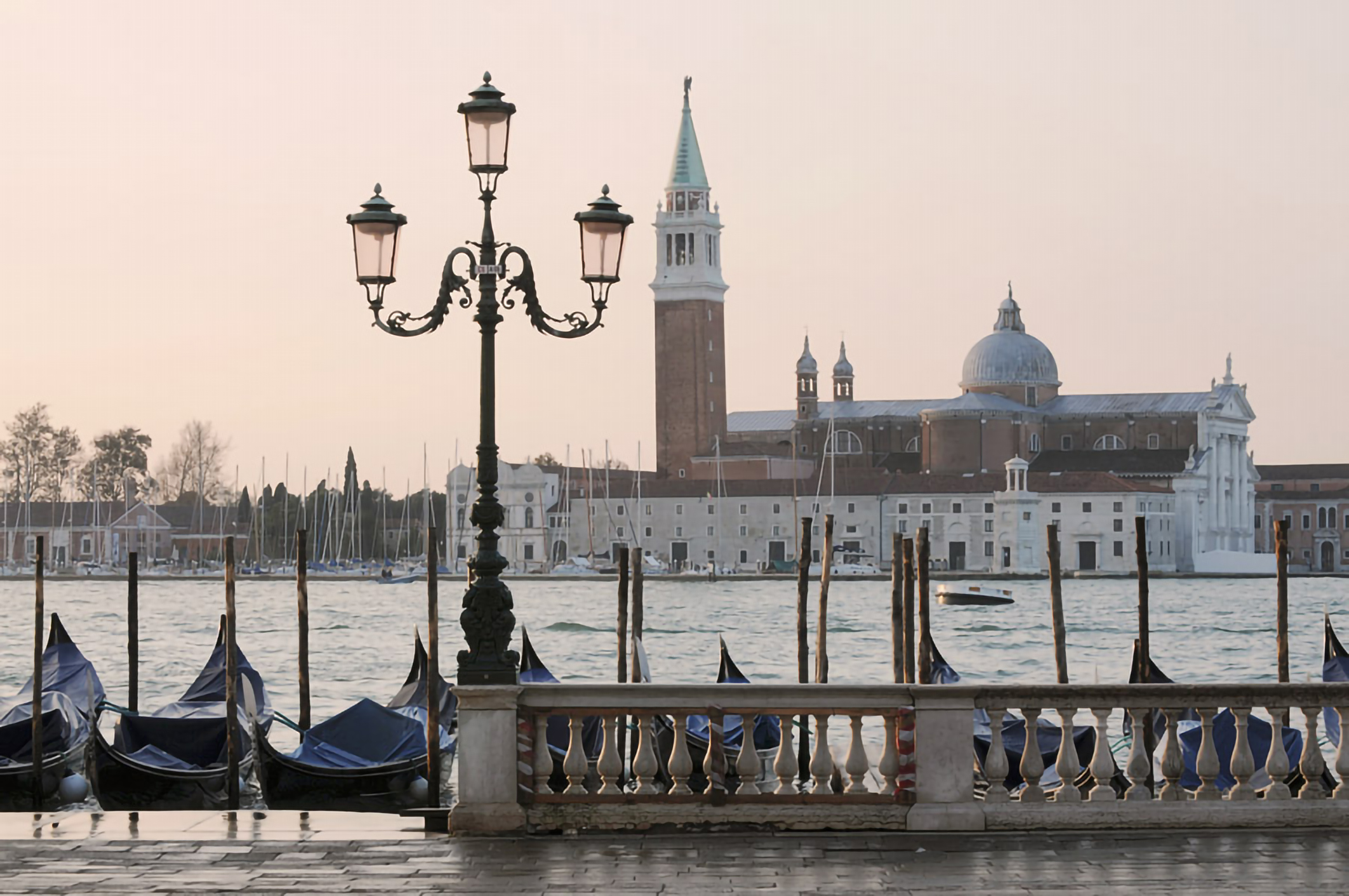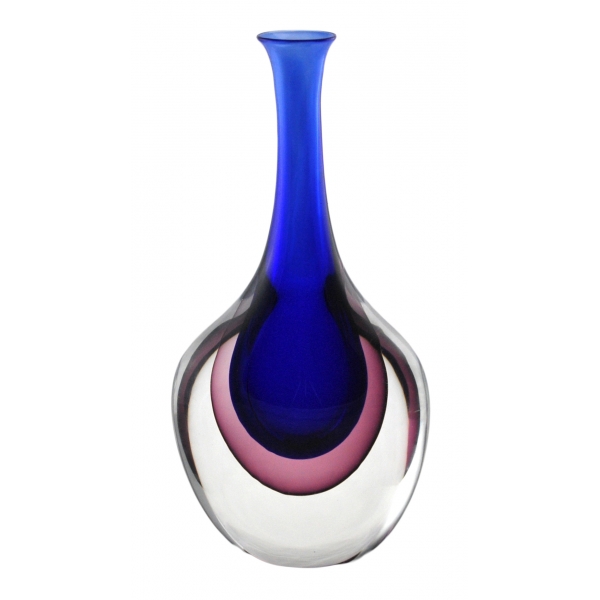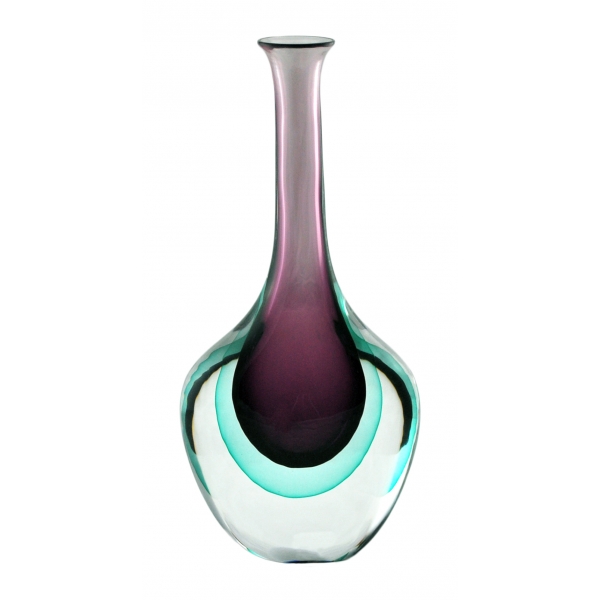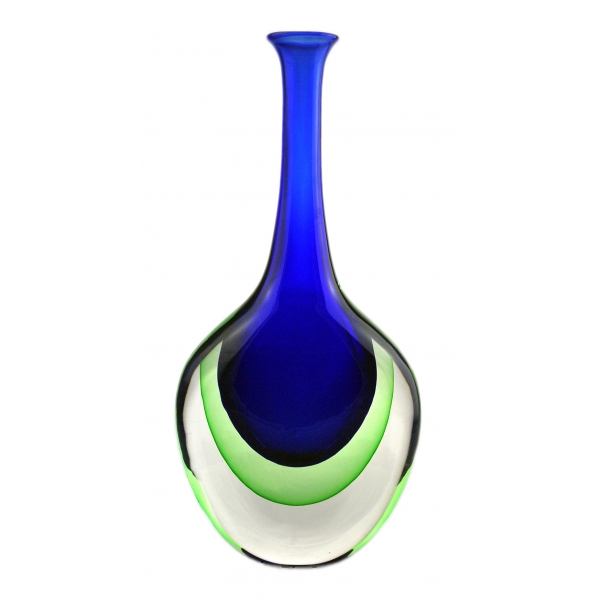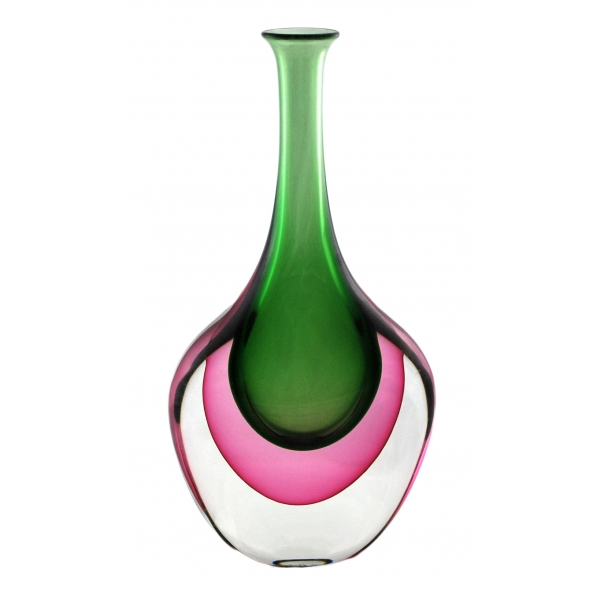No products
Categories
- Fashion Accessories
- Clothing
- Beauty & Lifestyle
-
Hi-Tech & Lifestyle
- Gaming
-
Case
- iPhone 11 Pro
- iPhone 11 Pro Max
- iPhone 11
- iPhone X / XS
- iPhone XS Max
- Samsung S10 / S10+ / S10e
- Huawei P30 / P30 Pro / P30 Lite
- Huawei P20 / P20 Pro / P20 Lite
- iPhone XR
- Samsung S9
- Samsung S9+
- iPhone 8 / 7
- iPhone 8 Plus / 7 Plus
- Samsung S8
- Samsung S8+
- Samsung S7
- Samsung S7 Edge
- iPhone 6 / 6 s
- iPhone 6 Plus / 6 s Plus
- iPhone 5 / SE
- Skin
- Audio
- Smart Home
- Drones & Hoverboard
- Photo & Video
- Desk Supplies
- Accessories
- Games
- Beverages
- Food
- Home
- Jewelry
- Luxury
- Travel
- Art
- Footwear
- Vintage Fashion
- Restaurants
- Sport
- Animals
- Gift Ideas
- Kidswear
Extra
Ars Cenedese Murano
High Quality and Exclusivity since 1946
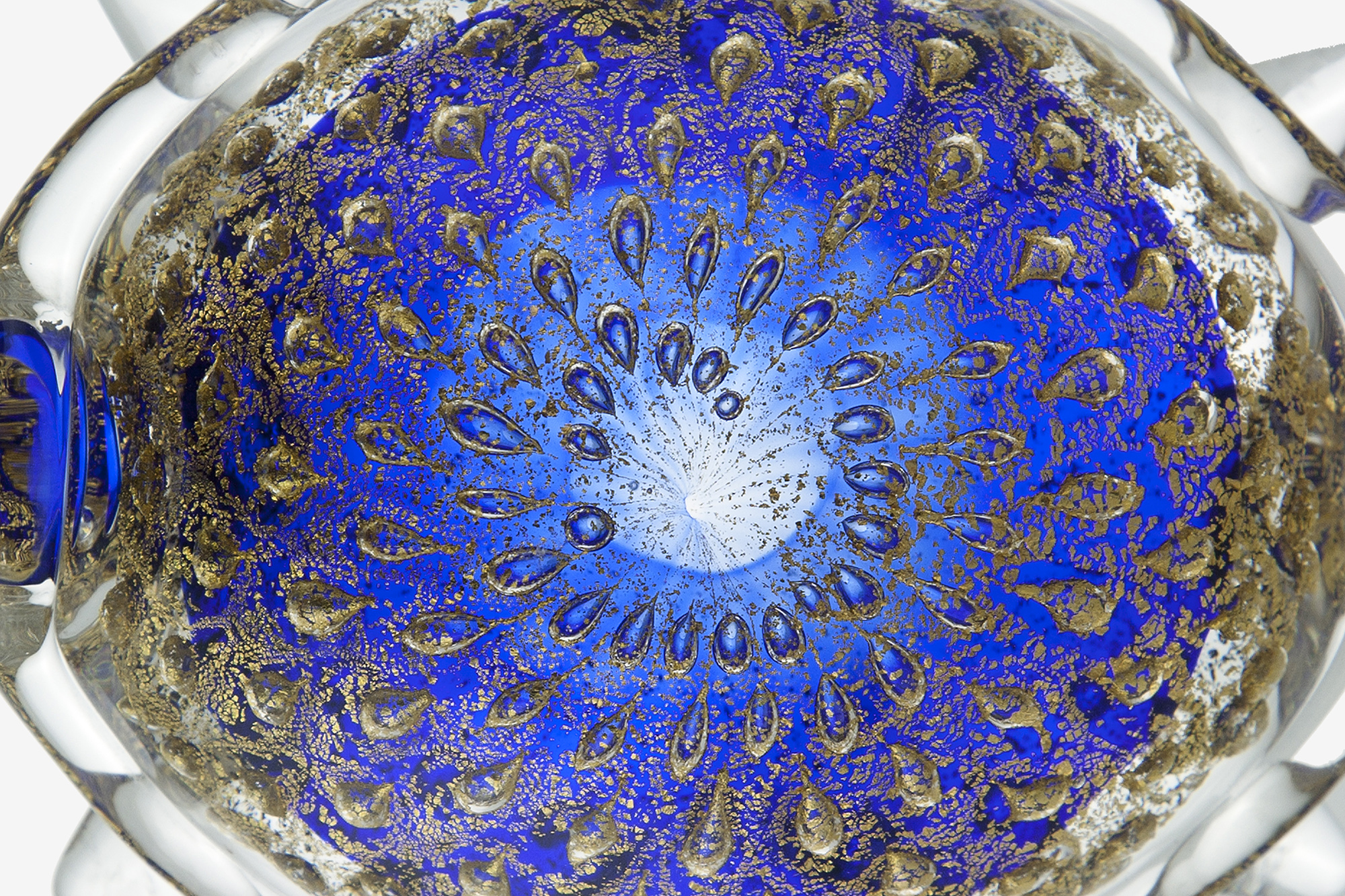
Artistic Murano Glass
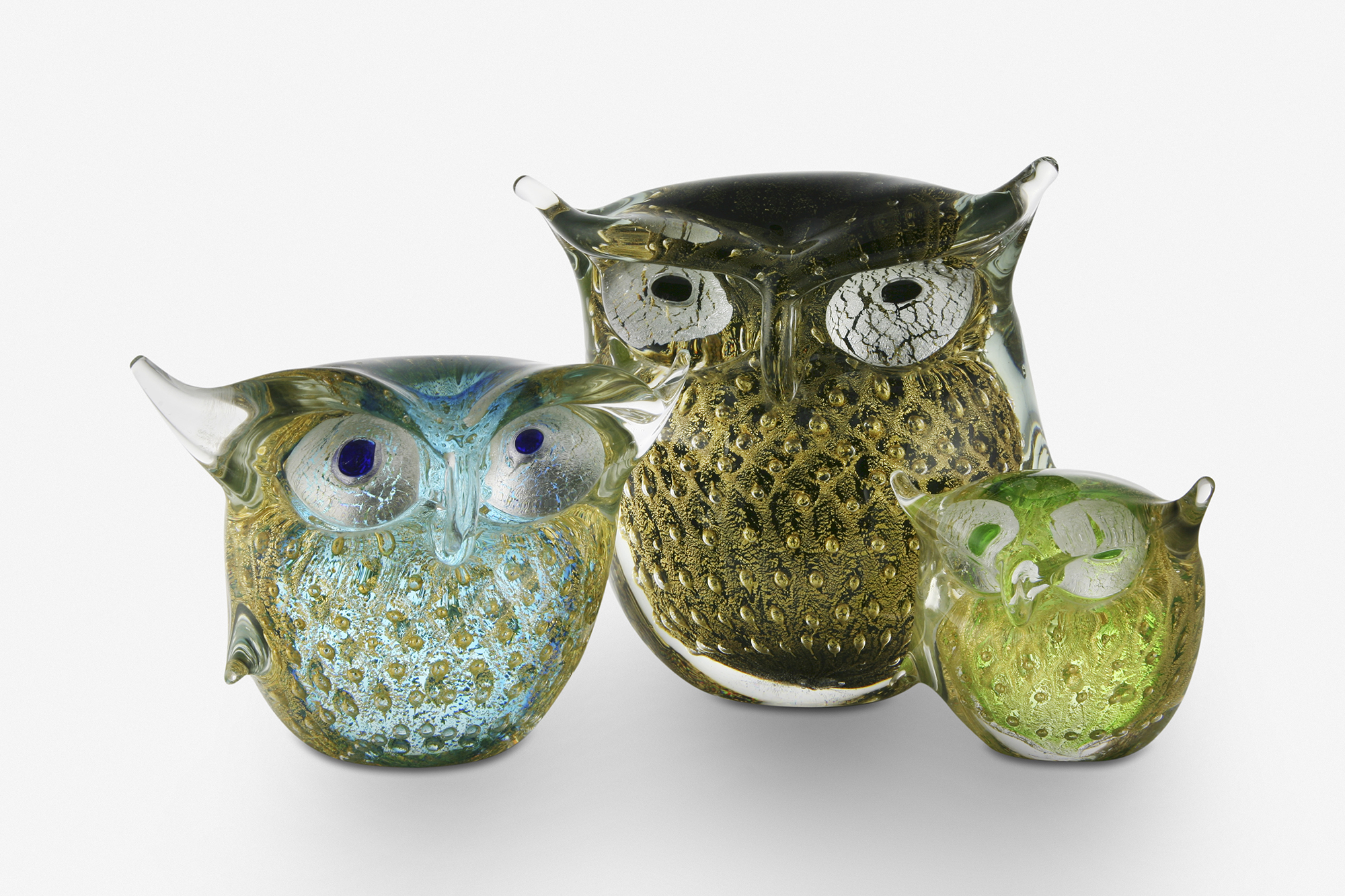
Venetian Glass Blowing Furnace since 1946
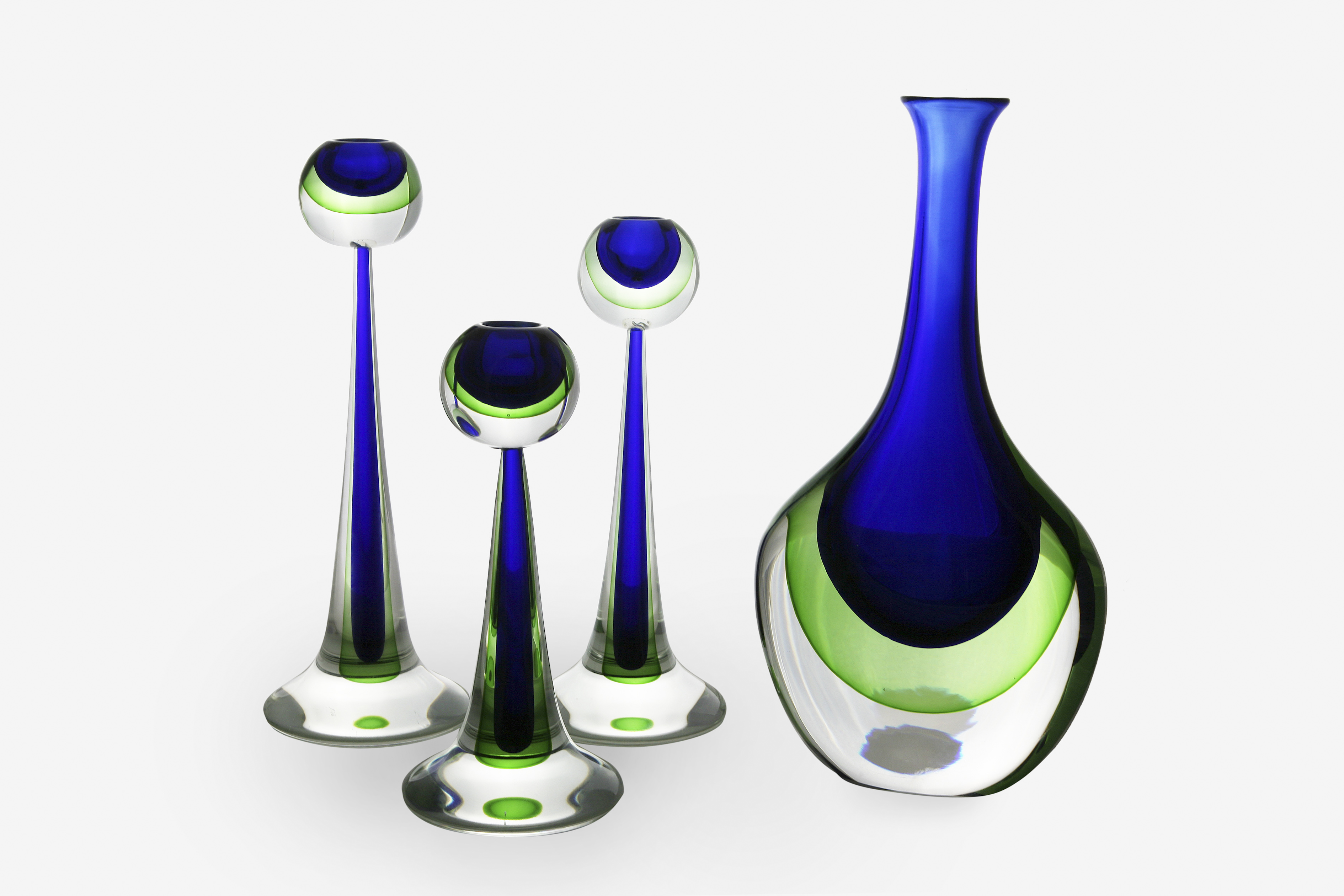
About Us
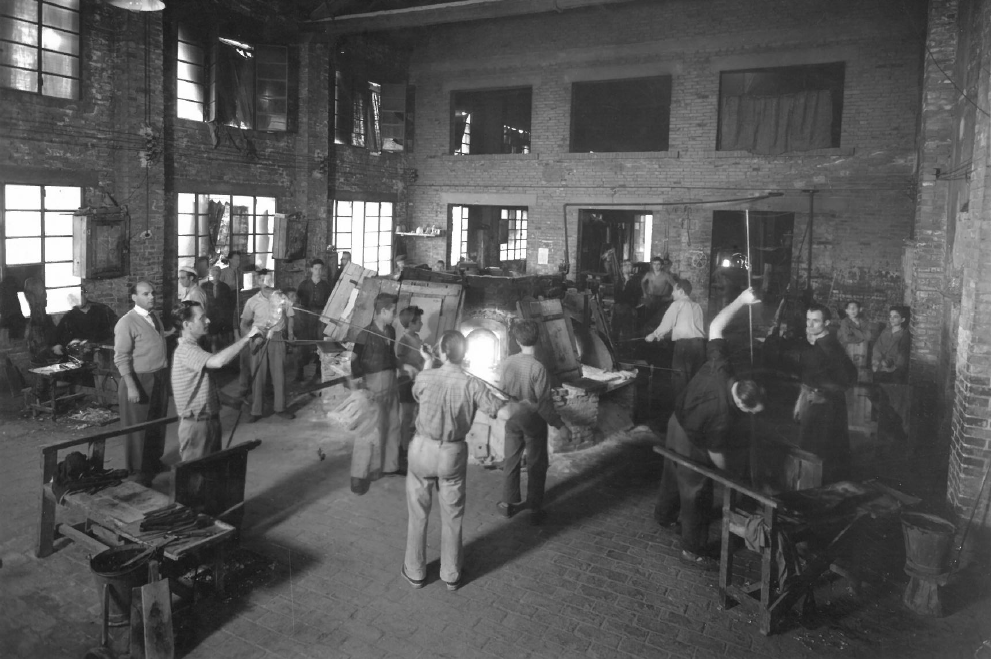
Founded in 1946, Ars Cenedese Murano, thanks to the high quality and exclusivity of its production, has soon established itself internationally as one of the most prestigious glass factories in the island of Murano, the world’s capital of artistic mouth-blown glassworks.

Though remaining closely bound to the ancient tradition of classical Murano glass (dating back form the 12th century) through the production of exquisite and refined pieces, Ars Cenedese Murano is constantly open to the suggestions of contemporary art, setting itself on the forefront of artistic glassmaking.

For its marked artistic sensibility and calling to excellence, thanks to the skills and capabilities of the glass masters, each and every item is unique and special, true image of the love for glass and Beauty.
Our History
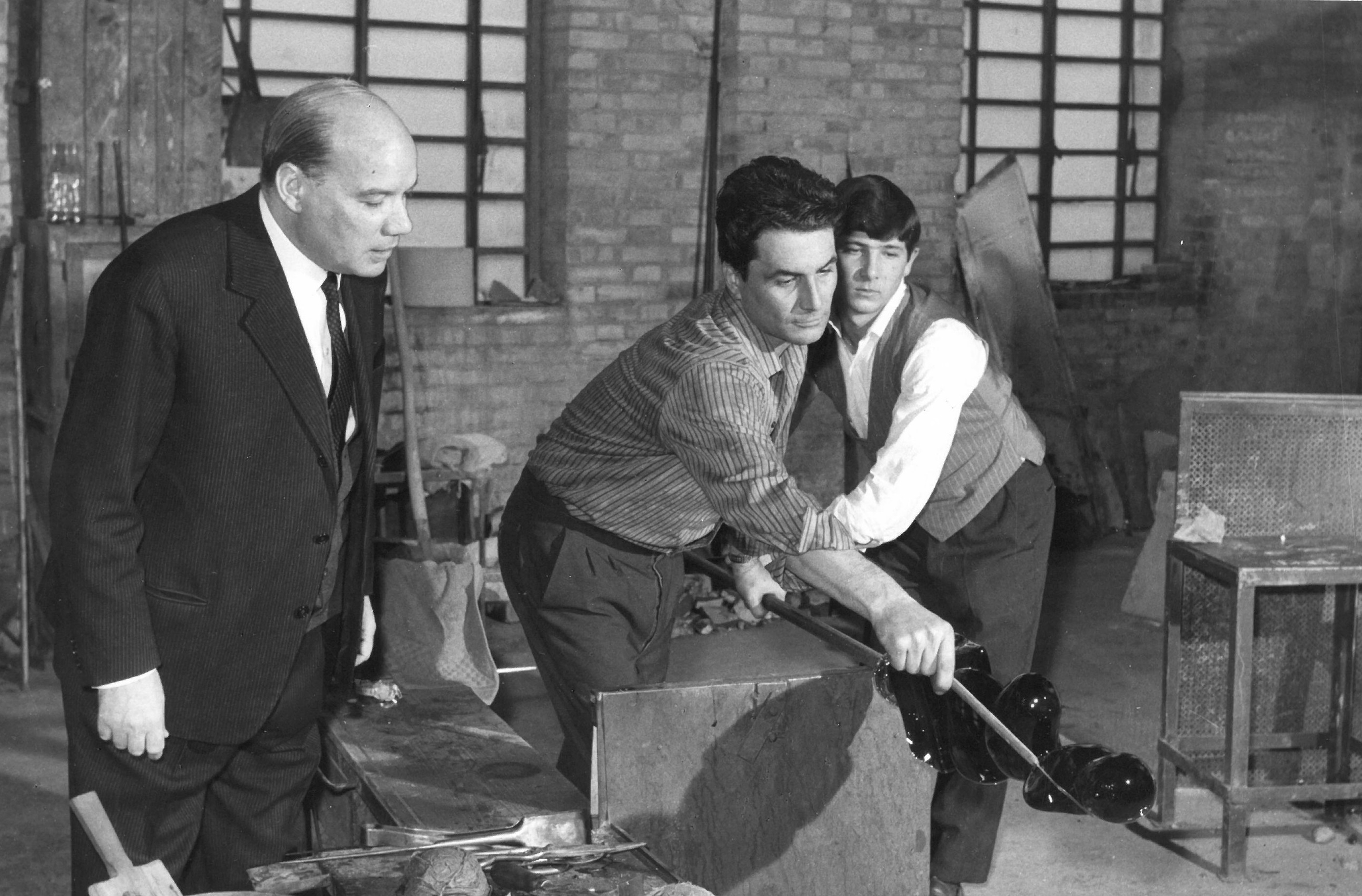
At the end of World War II, in 1946, after being tutored by various glass masters, Mr. Gino Cenedese (1907-1973) – anticipating a brighter era to come – established his own glass factory in partnership with the great glass masters of the time: Alfredo Barbini, Gino Fort, Angelo Tosi and Pietro Scaramal.
Remained the sole owner after the rescission of his partners in 1949, Mr. Cenedese weaved together the thousand-year-old Venetian glass-making tradition with the creative course of the great masters of the eighteenth century, the destiny of being born on an island of glassmakers with the artistic sensitivity and the entrepreneurial courage, and the technical expertise with the vocation of excellence.
Under his management, the factory soon acquired international renown for its highly prized and exclusive glass, developing greatly and emerging as one of the most qualified of the whole island of Murano.
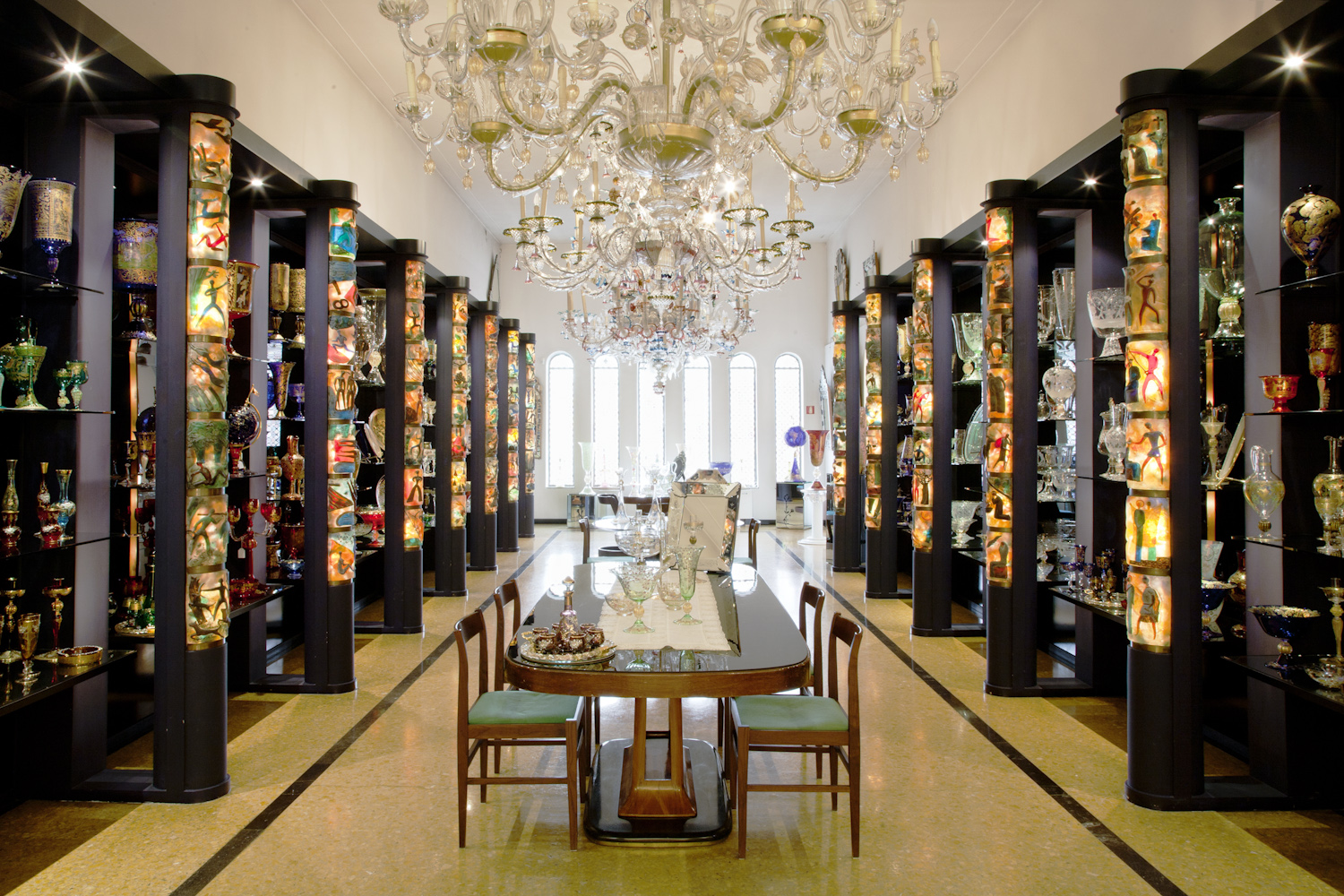
Though remaining closely bound to the ancient tradition of classical Murano glass – with hand blown glasses, vases, dishes, goblets and Venetian chandeliers – the production opened to the suggestions of contemporary art, pushed by a continuous research for new techniques and effects made possible by glass, and taking advantage of the collaboration with various artists and designers, each one bringing his personal interpretation of the material, colour, and light, each pieces marked out by the manual skill and the talent of the masters.
From 1953 to 1958 the collaboration with sculptor Napoleone Martinuzzi brought to life a series of female figures in solid glass and bas-relief panels that still adorn the firm’s showrooms, as well as large-sized chandeliers; while the cooperation with the painter Luigi Scarpa Croce led to the creation of “submerged” glass forms.
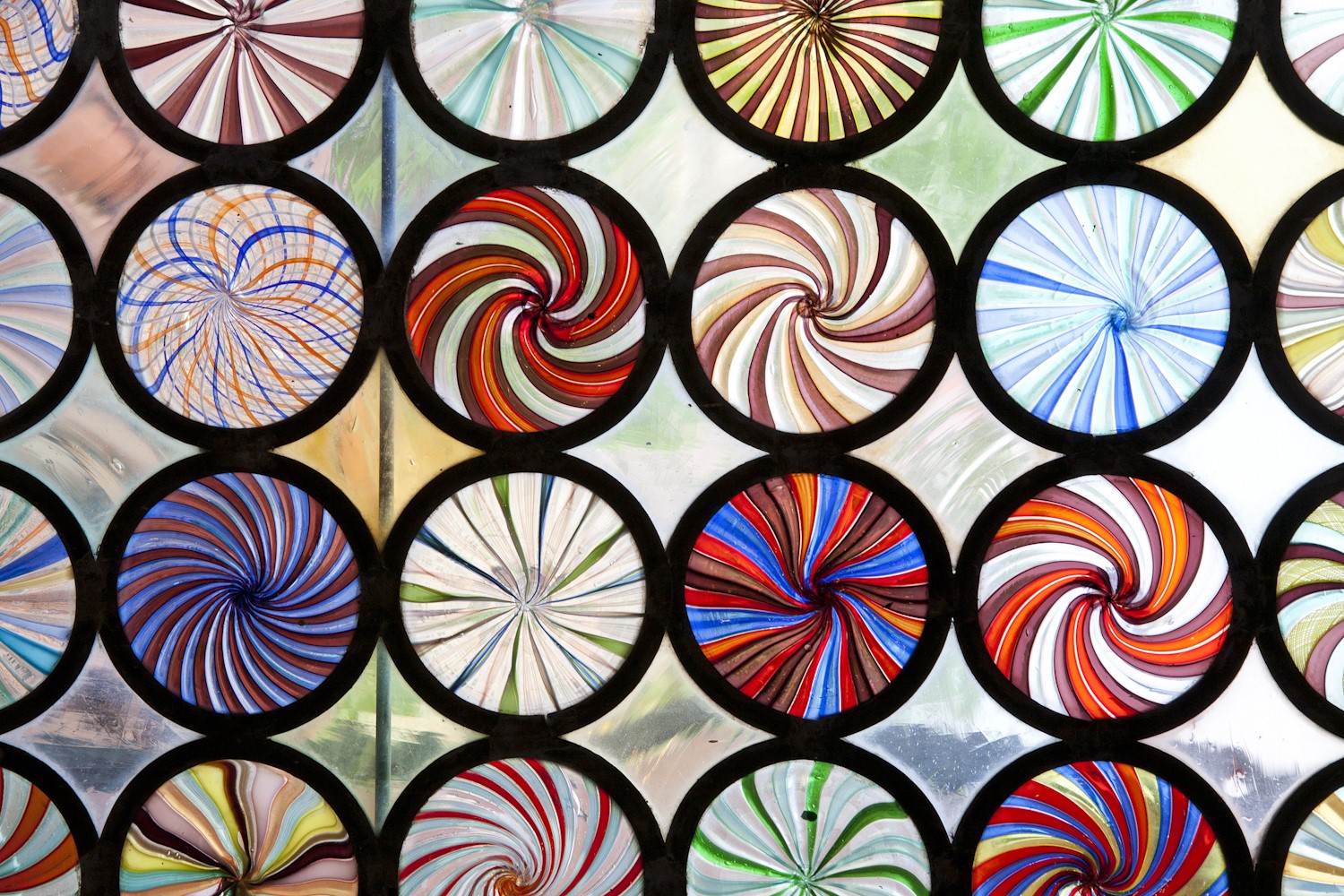
In the period going from 1954 to 1962, the designer Fulvio Bianconi worked with Cenedese and as a result some of his creations were exposed at the 1954 edition of the Biennale di Venezia, where Cenedese had already participated in 1952 with a thick and weighty block of glass with submerged abstract forms (reminding of a fish tank) created by the artist Riccardo Licata.
From 1963 to 1972 master glass-craftsman and artist Ermanno Nason was given freedom to work as he pleased at the factory. His production was extremely varied, pursuing – and reaching – the utmost quality and excellence, still unparalleled at present. In this period came also a collaboration with artist Harold Stevenson, who envisioned unique sculptures also inspired by the everchanging colours of the Venetian Lagoon (1968 –1969).
Subsequently the company undertook a continuing collaboration with Antonio Da Ros, a local artist fascinated by the decorative and chromatic possibilities of glass, who brought a fresh and enthusiastic approach that led to the search of unprecedented forms and chromatic effects. With Da Ros, the Sixties saw an important creation of the “submerged” glass forms among which the “Contrappunti”, fluids submerged playing on different tones of colours (works present at the various Venice Biennale Exhibitions, to many of the Milan Triennial Exhibitions and other important international exhibitions).
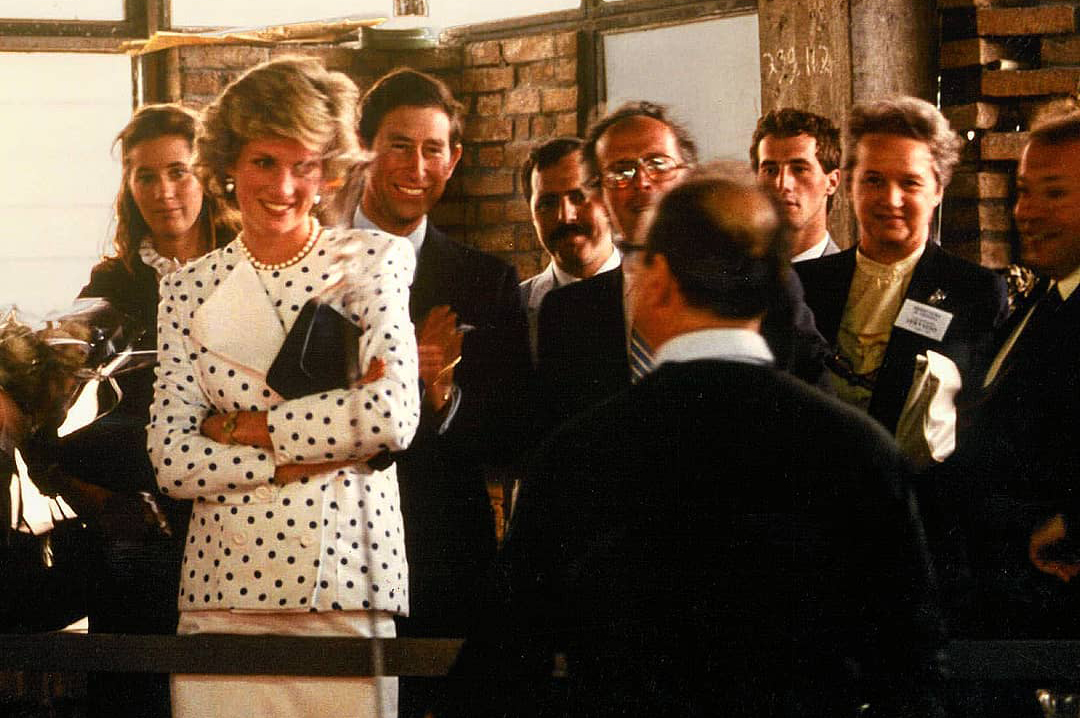
Ars Cenedese Murano still works today with the techniques and the art of a craft handed down through generations, creating time-less pieces destined to be unique.
Il Vetro Artistico di Murano

Why is It Different?
The secret of Murano glass lies in the craftsmanship of its production. A craftsmanship faithful to an almost millennial tradition handed down from generation to generation, treasuring the wisdom of the past and experimenting with new techniques for the future.
Why is Important to Understand The Difference?
Hand-crafted glass shows significant differences from its large-scale industrial version. The individual processing of each single hand-made item requires working methods completely different from the industrial ones: these can be traced back to three fundamental differences.
Greater Malleability
Hand-craftmanship involves the possibility of modeling the artistic item comprehensively, in a 360-degree process: for this very reason, the glass master will need more time and steps to shape its objects compared to automated industry, involving also greater commitment in terms of fatigue and corrections applied to refine the items while they are being created.
After centuries of theoretical and practical studies, as a result of countless attempts and slow conquests, Murano glass-masters have succeeded, through the development of a particular chemical structure and of tools specifically devised to facilitate their work, to obtain the greater malleability of Murano glass. Origianl Murano glass is characterized by the presence of greater quantities of carbonates and nitrates, such as sodium and potassium carbonate: these chemical elements allow for the glass to melt at lower temperatures and – most importantly- to solidify slowly, giving the glass-master more time to shape his objects. For these same reasons, Murano glass does not contain relevant percentages of lead, as this mineral would turn the glass too rigid (and therefore less malleable) for hand-blowing and -shaping. On the contrary, leaded glass is widely used in industrial glass-factories to obtain the typical gloss and transparency associated to machine-made or machine-assisted glass.
Unparalleled Colors
Murano glass colors range in a large variety of hues and shades, as each glass factory traditionally holds its own particular “recipe” of raw materials to combine in order to get a specific color.
The wide range of colors achievable with Murano glass is the result of empirical and theoretical studies carried over the centuries and jealously guarded — very unlike industrial colors that, often protected by official patents, become a common knowledge. In addition, colors such as yellow, ruby and red are particularly hard to obtain, due to the (minimum) deployment of cadmium: for instance, by modifying the percentage of minerals used and the processing time, different shades will result. This peculiarity makes original Murano glass even more unique, since each object is characterized by hues that may be exclusive and not always perfectly replicable.
The Know-How
The knowledge of glass-masters is passed from generation to generation, to young apprentices who develop in turn different techniques and specialize in specific processings of craft production. In this way, artistic objects are created, each of them containing centuries-old know-how, and unique characteristics at the same time.
Why are We so Proud of Our Products?
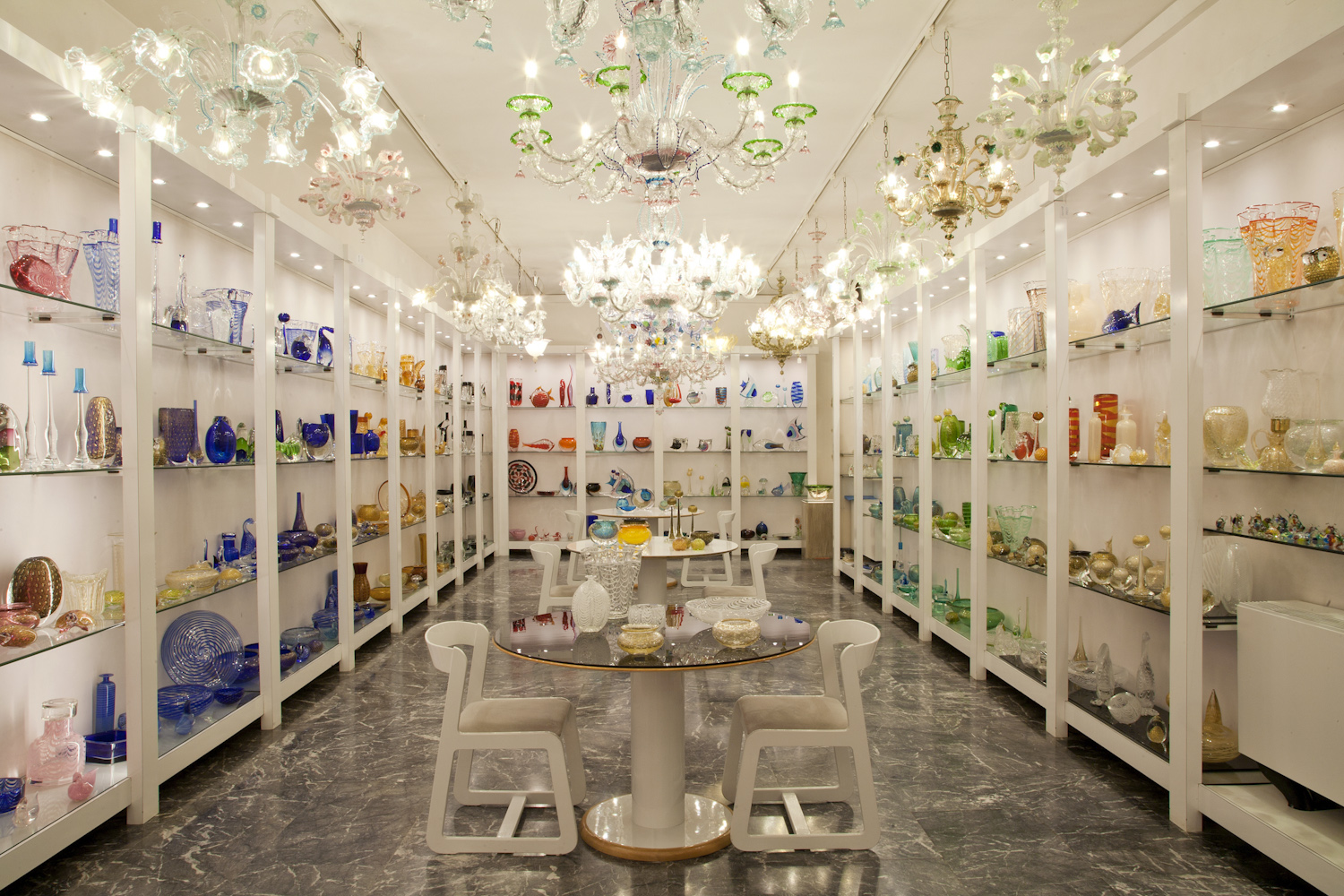
Because we Love It
In Ars Cenedese Murano we love the shapes and colors of our products, the numberless possibilities that only Murano glass malleability allows to explore – and, why not, the challanges we sometimes have to face and resolve – , and the heat radiating from our always active ovens.
Because It is Our Mission
Since 1946 we have specialized in the production and sale of artistic Murano glass, realizing every single product according to tradition and, at the same time, creating an iconic and up-to-date design.
Because It Takes Time
So many hours spent in glass-making are the guarantee of high-quality products, handled with care in every single working phase.
Why We Love It
We make it with passion!
Glassmasters
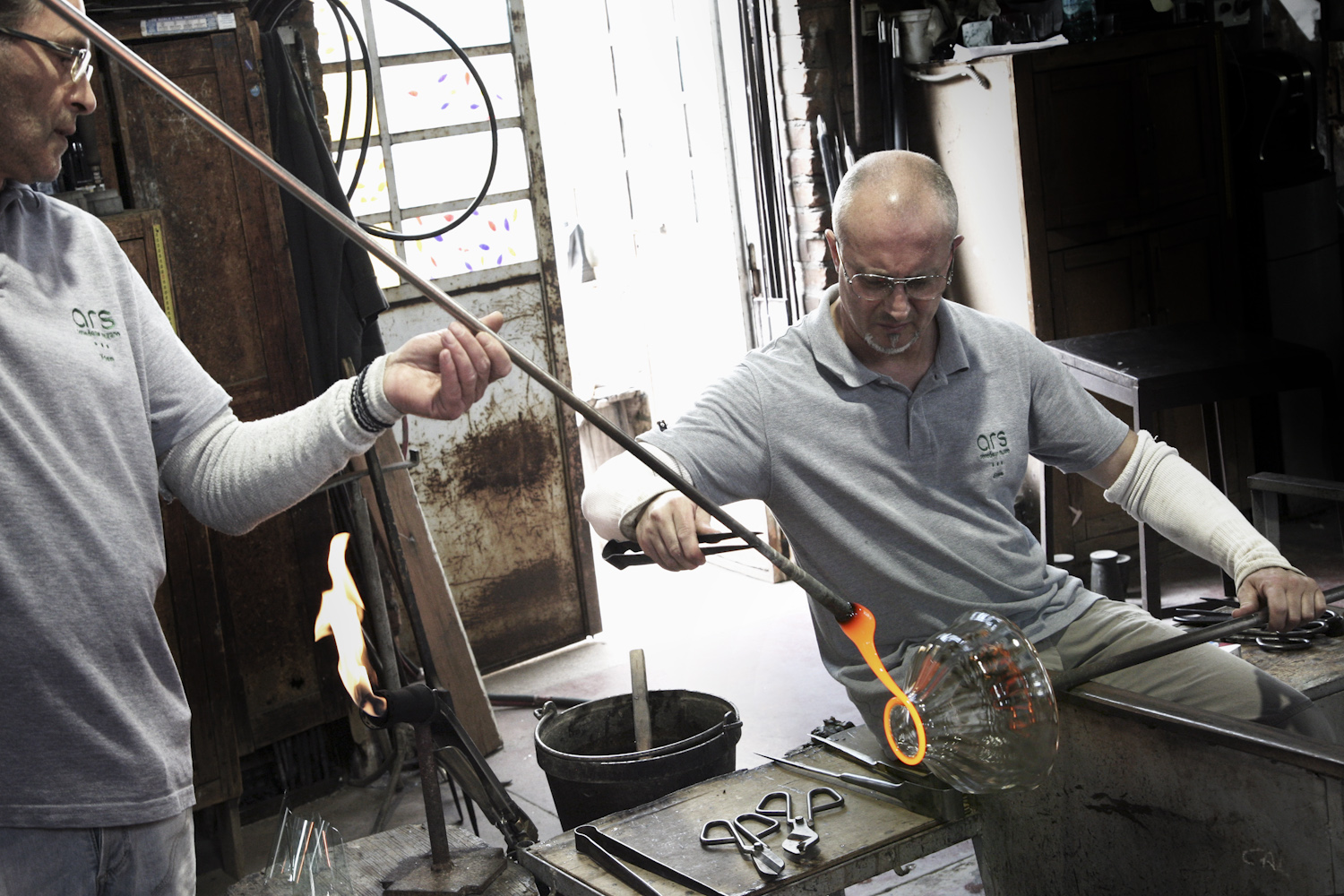
Antonio da Ros
Mr. Antonio Da Ros (1936-2012) graduated in 1957 from the Istituto Superiore di Arti Decorative ‘Carmini’ in Venice, getting the title of Professor in Decorative Arts and Architecture. mIn 1958, he started working with the glass factory Gino Cenedese (then Ars Cenedese Murano). The presence of Mr. Da Ros remained a permanent feature in the glass factory Cenedese, always working in close co-operation with the glass master craftsmen. Under his art direction, the factory developed various decorative lines of contemporary design, always at the highest standard. First, with the stylised forms with submersion of colored glass; in more recent years, with the technique of ‘scavo’ glass (a particular finish of the glass, looking like glass brought to light from archaeological excavations) an important decorative line was introduced in various new creations, all of which of great appeal for the simplicity of the lines, the preciousness of the material and the modernity of the colors. His last works were a return to the traditional Murano techniques of hand-blown glass, but re-interpreted with a contemporary sensibility; such as the ‘Venice dreams’ collection, as well as ‘Venezia I’ and ‘Venezia II’ collections.
Ermanno Nason
Maestro Ermanno Nason was born in Murano in 1928 from one of the oldest families in Murano; the first records of the family Nason name dates back to 1300. Mr. Nason started working at his father’s glass factory when he was 9 years old; he always said that the only way to learn effectively the art of glass making is to start at a very young age, watching closely and working next to great Masters of greater skills. After primary school, Mr. Nason attended the Drawing School for glass making apprentices, where he studied with Professor Vittorio Zecchin and Professor Luigi Scarpa Croce, dividing his time between classes and work in the furnace. In 1952 he was promoted ‘Maestro di prima piazza’ (i.e. leading Master in the glass furnace, the equivalent of a “first violin” in the music field).In 1953 a revolution took place in the world of glass: a number of celebrated artists – such as Chagall, Cocteau, Borsi, Picasso, Arnoldi, Arp, Guttuso, Klee, Kokoscha, Saetti, Max Ernst, Le Corbusier, Fontana, Minguzzi, Underwasser, Brindisi, etc. – draw some designs to be made out of glass, and Maestro Ermanno Nason was one of the greatest executors. Mr. Nason distinguished himself from the other craftsmen by his impeccable elegance of dress and manner, and most of all by his ability to create shapes and volumes without a single moment of hesitation – working without having to correct his error for, practically speaking, he rarely committed one. He specialized in the glass making technique called a massello, in which a block of glassy mass is stretched, shaped and fused, allowing multiple pieces to be joined without seams. From 1965 to 1972, Mr. Nason worked for the Gino Cenedese glass factory creating some original pieces of his own design, as well as executing designs of Professor Antonio Da Ros (Cenedese‘s resident designer) and other famous artists – such as Harold Stevenson and Silvestri. At Cenedese he was allowed to abandon routine production and work freely, innovating as he pleased; some pieces are bold and abstract, works no longer subject to judgement or expectations by others. Mr. Nason continued working in the furnace until 1993; his masterpieces are exhibited in museums all over the world, or are part of private collections. Maestro Ermanno Nason died in Jaunary 2013.
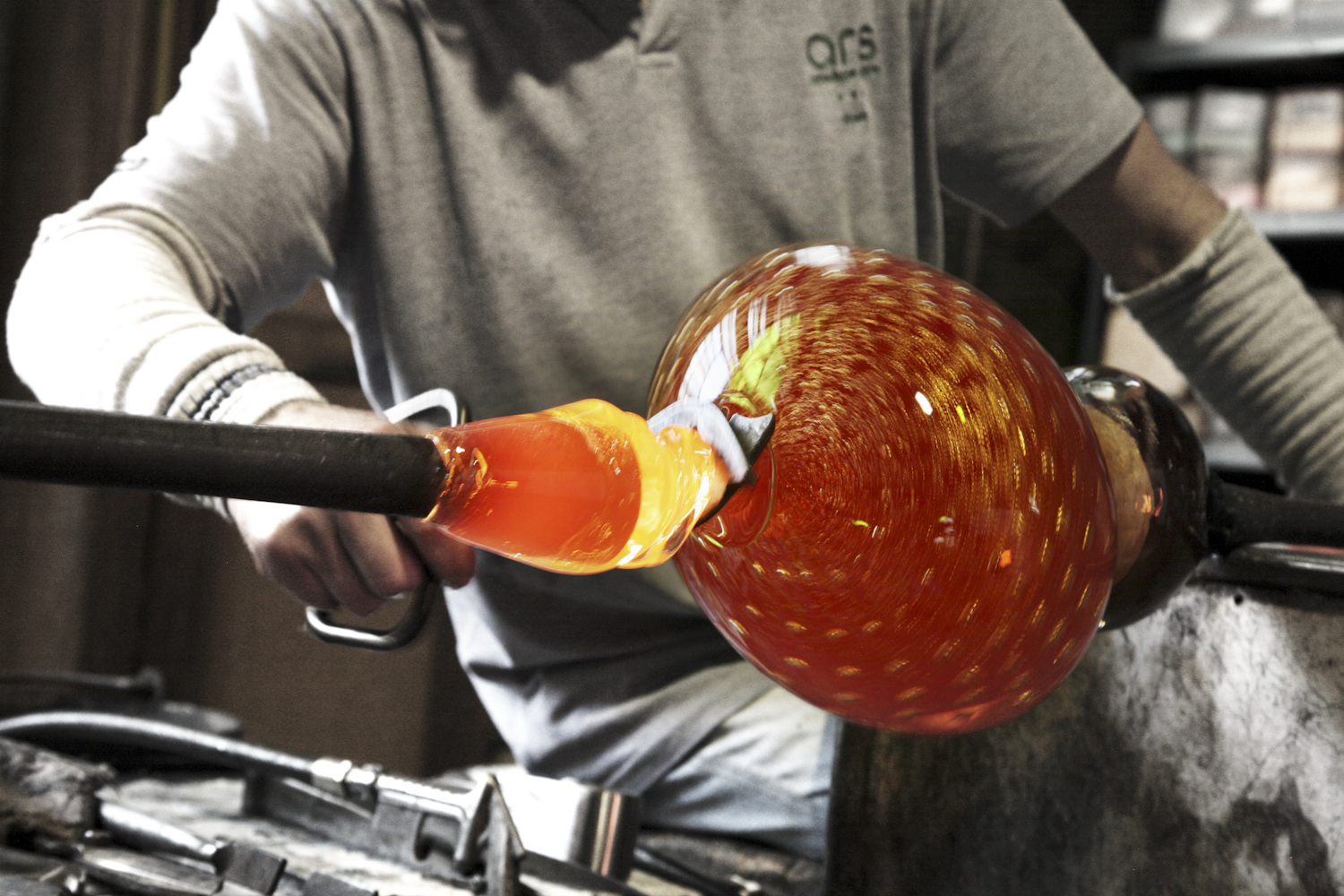
Napoleone Martinuzzi
Napoleone Martinuzzi (1892-1977) was an Italian sculptor and glass designer. Son of a famous Venetian glass master, between 1906 and 1909 he attends the school of Antonio Dal Zotto, at the Accademia delle Belle Arti of Venice. His first exhibition is at Ca’ Pesaro in Venice in 1908. From 1910 to 1911 he lives and works in Rome in the study of Angelo Zannelli. In 1914 he exhibits in Rome a white-marble sculpture at the Second Roman Secession exhibition. From then on he will display his works, mainly white marble and bronze sculptures, in the most important Italian and European exhibitions (Biennale di Venezia, Quadriennale di Roma and also in Paris, Bruxelles and Vienna). In 1917 he will start a co-operation with the famous poet and writer Gabriele D’Annunzio with whom he will design and realize famous sculptures such as “La Canefora”, “La Vittoria Alata” and “La Testa di Michelangelo” that can be seen at the Vittoriale in Rome along with many beautiful glass objects. From 1922 to 1931 he is the director of the Murano Glass Museum and in 1925 he will become partner and art director of the Venini glass factory. The collaboration with Venini results in a major breakthrough in glass design and techniques. In 1932 together with Francesco Zecchin he establishes a new glass factory and exhibits at the Triennale di Milano. After a period of transition in which he dedicates himself mainly to sculpturing, in 1947 and for five years he is art director for the Arte Vetro glass factory of Alberto Seguso and realizes glass sculptures of female torsos and heads. From 1953 to 1958 he co-operates with the Gino Cenedese glass factory realizing chandeliers, sculptures and bassorilievo glass panels in excavation style glass that can still be admired in the showrooms of Ars Cenedese Murano.
Giancarlo Begotti
The master decorator Giancarlo Begotti, born in Venice on December 5th, 1920, is reputed to be one of the greatest artists of the latest generations, for the hand-made decoration on the art glass works of Murano craftmen . Since approx. 50 years, he has operated in this field. Graduated from the Superior Institute of Decorative Arts ‘Carmini’ of Venice; he moved his first steps in the field of publicity design; and then, after the second world war , he became attracted by Murano glass and by the great possibilities and challenges in the decoration of this precious material.He has remained to work in the island of Murano; and an important period for his career have been the years spent at Cenedese’s, in close co-operation with the glass masters. These have been the years 60’s 70’s and early 80’s.Particularly, he has dedicated to the decoration with pure gold, called ‘GRAFFITO’ , and with coloured vitreous enamels; reviving the ancient techniques of the glorious Venetian Renaissance. For the subjects, he has inspired from the Venetian painters of ‘600 and ‘700 centuries; and also his own subjects, always from Venetian themes (ladies – knights – and ‘campiello’ scenes). His works have been exhibited in many Expositions in Europe – the most recent one in Lugano (Switzerland). Some of his works can be found in the private collections of some of the most important people in the world; such as the former president of China Hua Guoh Feng – the former president of the U.S.A., Jimmy Carter (a glass globe ‘Mappamondo’, made by Cenedese and painted in gold Graffito’ by Begotti, is kept in the White House Museum – Washington, D.C.).
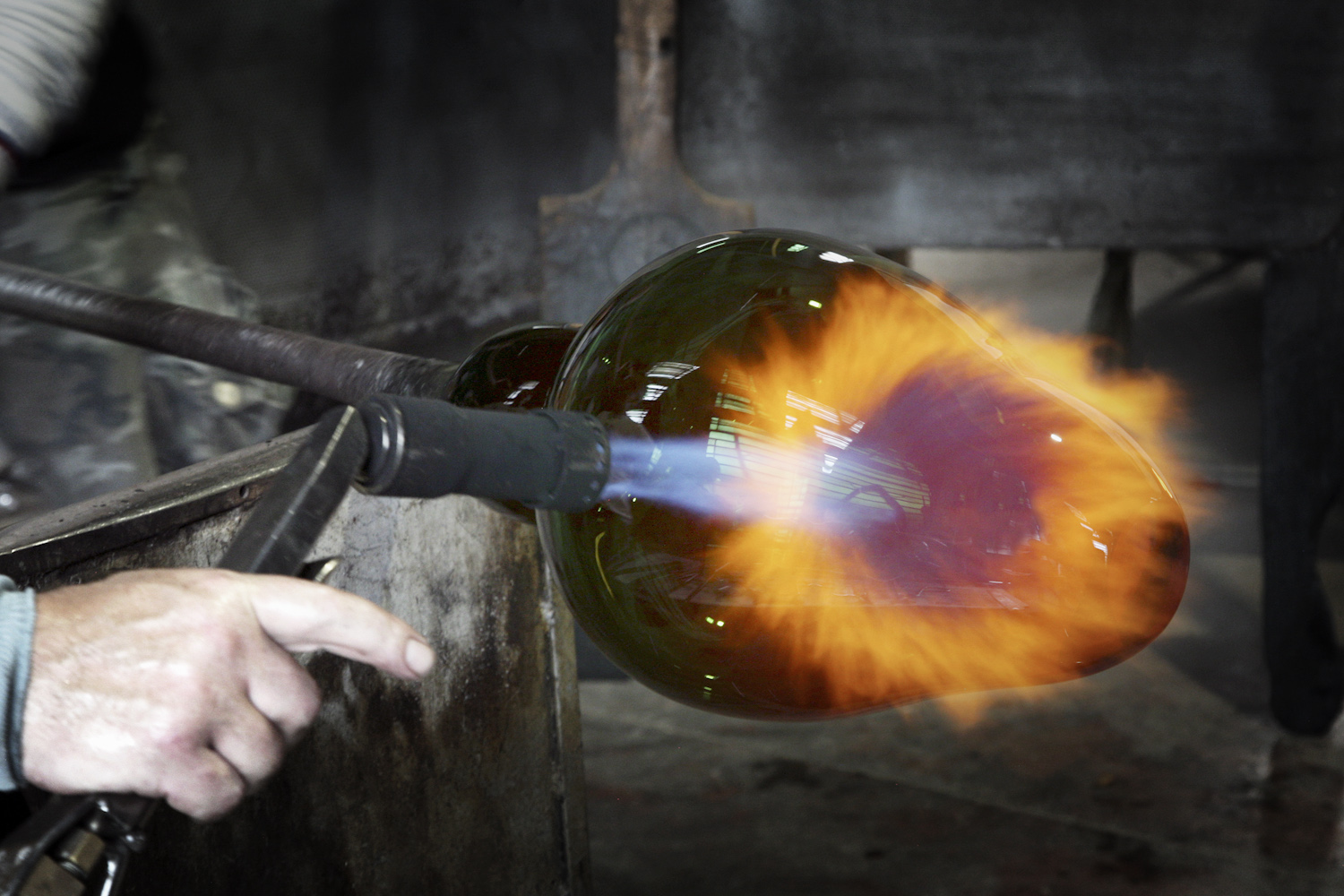
Maurizio Asti
Maestro Maurizio Asti was born in 1962 in Murano, where at present he works for the Ars Cenedese glass factory. Maestro Asti joined Cenedese in 1977 at the age of 15, starting as an apprentice next to the great maestro Fabio Tosi. Working with Maestro Tosi he has developed his skills and brought the ideas of Maestro Tosi to an even higher level. He has become a master in the Sommerso (overlay) technique in which he achieves the effect of colour suspended in to light by first applying a coloured overlay to a crystal core and then casing the piece in crystal, separating a sequence of overlays that appear to be floating inside. He has also developed new ideas in glass sculpturing and his realisations of abstract forms in the overlay technique are simply breathtaking. Maestro Asti is also continuing the work of Maestro Fabio Tosi in reproducing and manufacturing some traditional roman pieces and other modern pieces using the ‘Excavation’ technique, which by applying different kinds of minerals to the melting glass gives the objects a dull finish that capture nature’s own process of oxidation.

Elena Bucella
Master decorator Elena Bucella was born in Venice on October 1st, 1959. Since she was a child, she has always loved art and chosen to express herself though paintings and drawings.Just after finishing the mandatory school in 1976, she applied to join the Ars Cenedese Murano glass factory, where she knew an excellent art department still carried on the antique tradition of glass decoration.As customary for young pupils, she started working as an apprentice and trainee in the workshop. Young and talented, she soon displayed an exquisite skill and was taken under the protective wing of Mr. Guido Dorigo, then the chief decorator at Ars Cenedese Murano. Under his guidance she learned the trade and perfected her skills, excelling in the various aspects of glass decoration and eventually becoming the chief decorator at Ars Cenedese Murano after Mr. Dorigo’s retirement. Among her works are worth mentioning the glass Earth globe with gold graffito decoration, the reproduction of the Barovier wedding cup, several plates with reproductions of famous paintings, as well as beautiful sets of drinking glasses depicting scenes of 18th century Venetian life, using both the gold graffito and the colored enamels tecniques.
Glass Techniques

Bollinato
A particular decorative effect used in thick glass and consisting of a myriad of large and small “bubbles”, distributed in layers within the thickness of the glass. It may obtained with two methods. The first method requires the glass to be rolled on a plain metal surface covered with small sharp spikes so that, as they print a depression on the glass in its malleable state, it comes out with “holes” which will be then covered with another layer of glass, resulting in air bubbles trapped in correspondence to each “hole”. The second method involves the use of a conic mould patterned with spikes on the inside, in which the glass is blown, creating the air bubbles that will be covered by a layer of glass.
Filigrana
A refined hot-working technique invented at Murano in the first half of the 16th century. The complex working of “filigree” blown glass objects requires the use of crystal rods prepared beforehand and containing vitreous lattimo (milk glass) or coloured threads in smooth or spiral designs. There are various types: reticello or netted filigree, with a delicate thread net inside the crystal wall; a retortoli, twisted filigree with threads twisted into a spiral pattern (also called zanfirico after the venetian antique dealer Antonio Sanquirico, who commissioned numerous copies of antique glass pieces made using this technique in the first hal of the 19th century). The filigree, or reticello, is obtained using slim glass rods containing threads of opaque, usually white, glass. These rods, which are pencil shaped are placed side by side on a refractory plate and heated in the furnace until they melt and incorporate to became a single piece. The “slab” obtained in this way then “wrapped” around a cylinder of clear, incandescent glass so that only the internal thread (white or coloured) are visible. The glass is then blown as usual, and various objects (vases, glasses, etc.) modelled. In the case of the classic reticello technique, the operation described above is completed in two successive hot-working phases, the result of which is a criss-cross pattern. Considerable skill and artistic talents are needed to carry out this operation successfully.
Fenicio
A type of decoration obtained by applying the hot vitreous threads of pasta vitrea (opaque coloured glass with a ceramic-like consistency) around the walls of blown glass objects. These threads are then “combed” with a special tool in order to create repeated festoon motifs. Once reheated and blown, these can be incorporated into the wall of the object to produce a smooth surface. This decorative technique was introduced into the Murano glasswork at the end of the 16th century, but we do not know what it was called then. The term fenicio (Phoenician) was adopted during the 19th century when similar decorations were found in pre-Roman, Phoenician and Egyptian glassware.

Sommerso
Sommerso (submerged) is a decorating technique used to obtain several layers of glass in a single object. This thick glass is obtained by superimposing several layers of cristallo (clear) and transparent coloured glass, still attached to the blow-pipe, and repeatedly immersing the object during the process in the various pots of molten coloured glass. There are many variations on this technique because some layers of transparent glass can be replaced with other types of glass, for instance bubble glass, gold leaf glass etc., the inclusion of which produces fine chromatic effects. Sommerso glass was especially popular during the 1930s.
Scavo
Literally, excavation glass, for the particular finish alike to the antique Roman glass brought to light from excavation. The characteristic feature of this type of glass, introduced by Cenedese in the 1940s and then developed through the years, is an overall surface rough mat finish, predominantly grey but with splashes of various colours. The uneven appearance and opaque colour are the results of the reaction of salts and mineral oxides scattered over the surface of the object during the last phase of work.
Calcedonio
A vitreous paste with a dark base, red when transparent, with multicoloured veins, imitating a variety of natural chalcedony, zone agate. Invented in Murano in the mid 15th century, its difficult preparation requires the addition of various metallic compounds to the glass mixture, in specific ways and at specific intervals. The secret of its manufacture lost between the end of the 18th century and the first half of the 19th , was rediscovered by Lorenzo Radi in the 20h century.
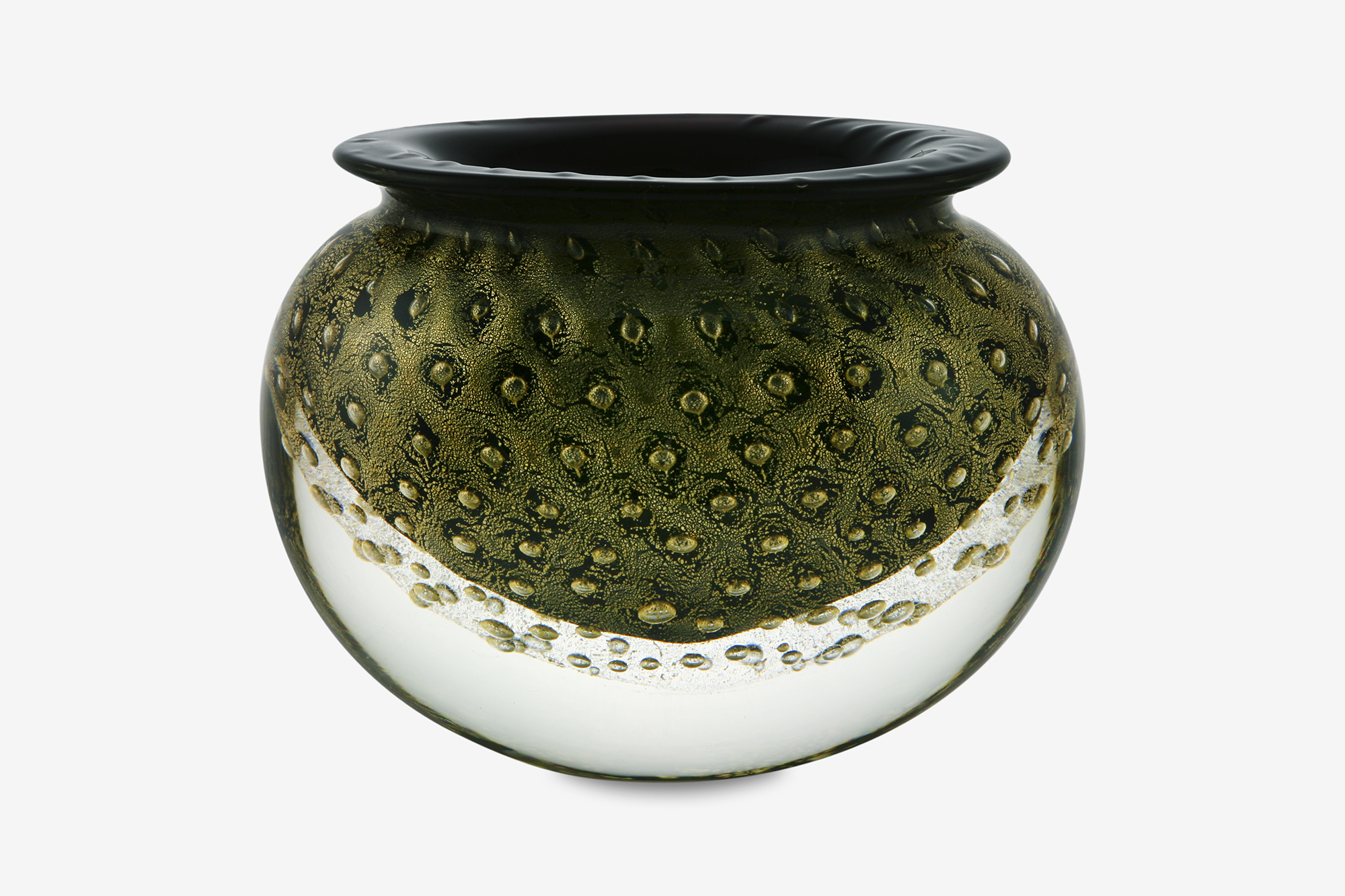
Zanfirico
Throughout the centuries in Murano the glass masters produced with glass several different kinds of coloured rods, all meant to be used together by heating them and by constructing a whole mass of glass which is then worked in a final shape. This techniques were widely used until the 16th century, when the downfall of Murano glass industry began. When it was “rediscovered” by the middle of the 19th century a Venetian antique dealer called Sanfiriquo contracted in such quantities the Murano glass factories for objects made in this technique reproducing the earlier designs that the entire range of different designs was since then called simply Zanfirico.Among the several designs of Zanfirico canes the most delicate is the half-filigree technique, the final aspect of a glass piece made in this technique is that of a piece completely “wrapped” in glass threads, all very close “packed” together.
Ballotton
This technique involves the use of a metal mould, that gives a cross-relief effect on glass. Inside the mould are small square-capped “points” (needles) which, when the glass is blown, result in the cross-relief pattern. With careful handling this depression are kept in place during the blowing and shaping process, leaving a geometrical pattern of great effect.
Avventurina
An especially prized glass paste, invented by Murano glassmakers during the first half of the 17th century. It was given this name because its manifacturing process was tricky and of uncertain success for even the most experienced glassmaker, and was therefore a ventura or chance. The preparation of ‘aventurine’ is long and delicate, resulting in the formation of small copper crystals, foliated and shining (stelle or stars, from whence stellaria, as ‘aventurine’ was also known in the past), and was kept a closely guarded secret across the centuries by a small number of skilled glassmakers. The glass is removed from the furnace in blocks, after having been slowly cooled, and its characteristic appearance can be seriously impaired during remelting. Once cold, it is cut like a hard stone, or worked hot with special care. Ordinary ‘aventurine’ is a brownish colour with stelle, whilst an even more highly valued type, known as verderame, takes on a copper green colour of superb effect.
Products Ars Cenedese Murano
Ars Cenedese Murano
High Quality and Exclusivity since 1946

Artistic Murano Glass

Venetian Glass Blowing Furnace since 1946

About Us

Founded in 1946, Ars Cenedese Murano, thanks to the high quality and exclusivity of its production, has soon established itself internationally as one of the most prestigious glass factories in the island of Murano, the world’s capital of artistic mouth-blown glassworks.

Though remaining closely bound to the ancient tradition of classical Murano glass (dating back form the 12th century) through the production of exquisite and refined pieces, Ars Cenedese Murano is constantly open to the suggestions of contemporary art, setting itself on the forefront of artistic glassmaking.

For its marked artistic sensibility and calling to excellence, thanks to the skills and capabilities of the glass masters, each and every item is unique and special, true image of the love for glass and Beauty.
Our History

At the end of World War II, in 1946, after being tutored by various glass masters, Mr. Gino Cenedese (1907-1973) – anticipating a brighter era to come – established his own glass factory in partnership with the great glass masters of the time: Alfredo Barbini, Gino Fort, Angelo Tosi and Pietro Scaramal.
Remained the sole owner after the rescission of his partners in 1949, Mr. Cenedese weaved together the thousand-year-old Venetian glass-making tradition with the creative course of the great masters of the eighteenth century, the destiny of being born on an island of glassmakers with the artistic sensitivity and the entrepreneurial courage, and the technical expertise with the vocation of excellence.
Under his management, the factory soon acquired international renown for its highly prized and exclusive glass, developing greatly and emerging as one of the most qualified of the whole island of Murano.

Though remaining closely bound to the ancient tradition of classical Murano glass – with hand blown glasses, vases, dishes, goblets and Venetian chandeliers – the production opened to the suggestions of contemporary art, pushed by a continuous research for new techniques and effects made possible by glass, and taking advantage of the collaboration with various artists and designers, each one bringing his personal interpretation of the material, colour, and light, each pieces marked out by the manual skill and the talent of the masters.
From 1953 to 1958 the collaboration with sculptor Napoleone Martinuzzi brought to life a series of female figures in solid glass and bas-relief panels that still adorn the firm’s showrooms, as well as large-sized chandeliers; while the cooperation with the painter Luigi Scarpa Croce led to the creation of “submerged” glass forms.

In the period going from 1954 to 1962, the designer Fulvio Bianconi worked with Cenedese and as a result some of his creations were exposed at the 1954 edition of the Biennale di Venezia, where Cenedese had already participated in 1952 with a thick and weighty block of glass with submerged abstract forms (reminding of a fish tank) created by the artist Riccardo Licata.
From 1963 to 1972 master glass-craftsman and artist Ermanno Nason was given freedom to work as he pleased at the factory. His production was extremely varied, pursuing – and reaching – the utmost quality and excellence, still unparalleled at present. In this period came also a collaboration with artist Harold Stevenson, who envisioned unique sculptures also inspired by the everchanging colours of the Venetian Lagoon (1968 –1969).
Subsequently the company undertook a continuing collaboration with Antonio Da Ros, a local artist fascinated by the decorative and chromatic possibilities of glass, who brought a fresh and enthusiastic approach that led to the search of unprecedented forms and chromatic effects. With Da Ros, the Sixties saw an important creation of the “submerged” glass forms among which the “Contrappunti”, fluids submerged playing on different tones of colours (works present at the various Venice Biennale Exhibitions, to many of the Milan Triennial Exhibitions and other important international exhibitions).

Ars Cenedese Murano still works today with the techniques and the art of a craft handed down through generations, creating time-less pieces destined to be unique.
Il Vetro Artistico di Murano

Why is It Different?
The secret of Murano glass lies in the craftsmanship of its production. A craftsmanship faithful to an almost millennial tradition handed down from generation to generation, treasuring the wisdom of the past and experimenting with new techniques for the future.
Why is Important to Understand The Difference?
Hand-crafted glass shows significant differences from its large-scale industrial version. The individual processing of each single hand-made item requires working methods completely different from the industrial ones: these can be traced back to three fundamental differences.
Greater Malleability
Hand-craftmanship involves the possibility of modeling the artistic item comprehensively, in a 360-degree process: for this very reason, the glass master will need more time and steps to shape its objects compared to automated industry, involving also greater commitment in terms of fatigue and corrections applied to refine the items while they are being created.
After centuries of theoretical and practical studies, as a result of countless attempts and slow conquests, Murano glass-masters have succeeded, through the development of a particular chemical structure and of tools specifically devised to facilitate their work, to obtain the greater malleability of Murano glass. Origianl Murano glass is characterized by the presence of greater quantities of carbonates and nitrates, such as sodium and potassium carbonate: these chemical elements allow for the glass to melt at lower temperatures and – most importantly- to solidify slowly, giving the glass-master more time to shape his objects. For these same reasons, Murano glass does not contain relevant percentages of lead, as this mineral would turn the glass too rigid (and therefore less malleable) for hand-blowing and -shaping. On the contrary, leaded glass is widely used in industrial glass-factories to obtain the typical gloss and transparency associated to machine-made or machine-assisted glass.
Unparalleled Colors
Murano glass colors range in a large variety of hues and shades, as each glass factory traditionally holds its own particular “recipe” of raw materials to combine in order to get a specific color.
The wide range of colors achievable with Murano glass is the result of empirical and theoretical studies carried over the centuries and jealously guarded — very unlike industrial colors that, often protected by official patents, become a common knowledge. In addition, colors such as yellow, ruby and red are particularly hard to obtain, due to the (minimum) deployment of cadmium: for instance, by modifying the percentage of minerals used and the processing time, different shades will result. This peculiarity makes original Murano glass even more unique, since each object is characterized by hues that may be exclusive and not always perfectly replicable.
The Know-How
The knowledge of glass-masters is passed from generation to generation, to young apprentices who develop in turn different techniques and specialize in specific processings of craft production. In this way, artistic objects are created, each of them containing centuries-old know-how, and unique characteristics at the same time.
Why are We so Proud of Our Products?

Because we Love It
In Ars Cenedese Murano we love the shapes and colors of our products, the numberless possibilities that only Murano glass malleability allows to explore – and, why not, the challanges we sometimes have to face and resolve – , and the heat radiating from our always active ovens.
Because It is Our Mission
Since 1946 we have specialized in the production and sale of artistic Murano glass, realizing every single product according to tradition and, at the same time, creating an iconic and up-to-date design.
Because It Takes Time
So many hours spent in glass-making are the guarantee of high-quality products, handled with care in every single working phase.
Why We Love It
We make it with passion!
Glassmasters

Antonio da Ros
Mr. Antonio Da Ros (1936-2012) graduated in 1957 from the Istituto Superiore di Arti Decorative ‘Carmini’ in Venice, getting the title of Professor in Decorative Arts and Architecture. mIn 1958, he started working with the glass factory Gino Cenedese (then Ars Cenedese Murano). The presence of Mr. Da Ros remained a permanent feature in the glass factory Cenedese, always working in close co-operation with the glass master craftsmen. Under his art direction, the factory developed various decorative lines of contemporary design, always at the highest standard. First, with the stylised forms with submersion of colored glass; in more recent years, with the technique of ‘scavo’ glass (a particular finish of the glass, looking like glass brought to light from archaeological excavations) an important decorative line was introduced in various new creations, all of which of great appeal for the simplicity of the lines, the preciousness of the material and the modernity of the colors. His last works were a return to the traditional Murano techniques of hand-blown glass, but re-interpreted with a contemporary sensibility; such as the ‘Venice dreams’ collection, as well as ‘Venezia I’ and ‘Venezia II’ collections.
Ermanno Nason
Maestro Ermanno Nason was born in Murano in 1928 from one of the oldest families in Murano; the first records of the family Nason name dates back to 1300. Mr. Nason started working at his father’s glass factory when he was 9 years old; he always said that the only way to learn effectively the art of glass making is to start at a very young age, watching closely and working next to great Masters of greater skills. After primary school, Mr. Nason attended the Drawing School for glass making apprentices, where he studied with Professor Vittorio Zecchin and Professor Luigi Scarpa Croce, dividing his time between classes and work in the furnace. In 1952 he was promoted ‘Maestro di prima piazza’ (i.e. leading Master in the glass furnace, the equivalent of a “first violin” in the music field).In 1953 a revolution took place in the world of glass: a number of celebrated artists – such as Chagall, Cocteau, Borsi, Picasso, Arnoldi, Arp, Guttuso, Klee, Kokoscha, Saetti, Max Ernst, Le Corbusier, Fontana, Minguzzi, Underwasser, Brindisi, etc. – draw some designs to be made out of glass, and Maestro Ermanno Nason was one of the greatest executors. Mr. Nason distinguished himself from the other craftsmen by his impeccable elegance of dress and manner, and most of all by his ability to create shapes and volumes without a single moment of hesitation – working without having to correct his error for, practically speaking, he rarely committed one. He specialized in the glass making technique called a massello, in which a block of glassy mass is stretched, shaped and fused, allowing multiple pieces to be joined without seams. From 1965 to 1972, Mr. Nason worked for the Gino Cenedese glass factory creating some original pieces of his own design, as well as executing designs of Professor Antonio Da Ros (Cenedese‘s resident designer) and other famous artists – such as Harold Stevenson and Silvestri. At Cenedese he was allowed to abandon routine production and work freely, innovating as he pleased; some pieces are bold and abstract, works no longer subject to judgement or expectations by others. Mr. Nason continued working in the furnace until 1993; his masterpieces are exhibited in museums all over the world, or are part of private collections. Maestro Ermanno Nason died in Jaunary 2013.

Napoleone Martinuzzi
Napoleone Martinuzzi (1892-1977) was an Italian sculptor and glass designer. Son of a famous Venetian glass master, between 1906 and 1909 he attends the school of Antonio Dal Zotto, at the Accademia delle Belle Arti of Venice. His first exhibition is at Ca’ Pesaro in Venice in 1908. From 1910 to 1911 he lives and works in Rome in the study of Angelo Zannelli. In 1914 he exhibits in Rome a white-marble sculpture at the Second Roman Secession exhibition. From then on he will display his works, mainly white marble and bronze sculptures, in the most important Italian and European exhibitions (Biennale di Venezia, Quadriennale di Roma and also in Paris, Bruxelles and Vienna). In 1917 he will start a co-operation with the famous poet and writer Gabriele D’Annunzio with whom he will design and realize famous sculptures such as “La Canefora”, “La Vittoria Alata” and “La Testa di Michelangelo” that can be seen at the Vittoriale in Rome along with many beautiful glass objects. From 1922 to 1931 he is the director of the Murano Glass Museum and in 1925 he will become partner and art director of the Venini glass factory. The collaboration with Venini results in a major breakthrough in glass design and techniques. In 1932 together with Francesco Zecchin he establishes a new glass factory and exhibits at the Triennale di Milano. After a period of transition in which he dedicates himself mainly to sculpturing, in 1947 and for five years he is art director for the Arte Vetro glass factory of Alberto Seguso and realizes glass sculptures of female torsos and heads. From 1953 to 1958 he co-operates with the Gino Cenedese glass factory realizing chandeliers, sculptures and bassorilievo glass panels in excavation style glass that can still be admired in the showrooms of Ars Cenedese Murano.
Giancarlo Begotti
The master decorator Giancarlo Begotti, born in Venice on December 5th, 1920, is reputed to be one of the greatest artists of the latest generations, for the hand-made decoration on the art glass works of Murano craftmen . Since approx. 50 years, he has operated in this field. Graduated from the Superior Institute of Decorative Arts ‘Carmini’ of Venice; he moved his first steps in the field of publicity design; and then, after the second world war , he became attracted by Murano glass and by the great possibilities and challenges in the decoration of this precious material.He has remained to work in the island of Murano; and an important period for his career have been the years spent at Cenedese’s, in close co-operation with the glass masters. These have been the years 60’s 70’s and early 80’s.Particularly, he has dedicated to the decoration with pure gold, called ‘GRAFFITO’ , and with coloured vitreous enamels; reviving the ancient techniques of the glorious Venetian Renaissance. For the subjects, he has inspired from the Venetian painters of ‘600 and ‘700 centuries; and also his own subjects, always from Venetian themes (ladies – knights – and ‘campiello’ scenes). His works have been exhibited in many Expositions in Europe – the most recent one in Lugano (Switzerland). Some of his works can be found in the private collections of some of the most important people in the world; such as the former president of China Hua Guoh Feng – the former president of the U.S.A., Jimmy Carter (a glass globe ‘Mappamondo’, made by Cenedese and painted in gold Graffito’ by Begotti, is kept in the White House Museum – Washington, D.C.).

Maurizio Asti
Maestro Maurizio Asti was born in 1962 in Murano, where at present he works for the Ars Cenedese glass factory. Maestro Asti joined Cenedese in 1977 at the age of 15, starting as an apprentice next to the great maestro Fabio Tosi. Working with Maestro Tosi he has developed his skills and brought the ideas of Maestro Tosi to an even higher level. He has become a master in the Sommerso (overlay) technique in which he achieves the effect of colour suspended in to light by first applying a coloured overlay to a crystal core and then casing the piece in crystal, separating a sequence of overlays that appear to be floating inside. He has also developed new ideas in glass sculpturing and his realisations of abstract forms in the overlay technique are simply breathtaking. Maestro Asti is also continuing the work of Maestro Fabio Tosi in reproducing and manufacturing some traditional roman pieces and other modern pieces using the ‘Excavation’ technique, which by applying different kinds of minerals to the melting glass gives the objects a dull finish that capture nature’s own process of oxidation.

Elena Bucella
Master decorator Elena Bucella was born in Venice on October 1st, 1959. Since she was a child, she has always loved art and chosen to express herself though paintings and drawings.Just after finishing the mandatory school in 1976, she applied to join the Ars Cenedese Murano glass factory, where she knew an excellent art department still carried on the antique tradition of glass decoration.As customary for young pupils, she started working as an apprentice and trainee in the workshop. Young and talented, she soon displayed an exquisite skill and was taken under the protective wing of Mr. Guido Dorigo, then the chief decorator at Ars Cenedese Murano. Under his guidance she learned the trade and perfected her skills, excelling in the various aspects of glass decoration and eventually becoming the chief decorator at Ars Cenedese Murano after Mr. Dorigo’s retirement. Among her works are worth mentioning the glass Earth globe with gold graffito decoration, the reproduction of the Barovier wedding cup, several plates with reproductions of famous paintings, as well as beautiful sets of drinking glasses depicting scenes of 18th century Venetian life, using both the gold graffito and the colored enamels tecniques.
Glass Techniques

Bollinato
A particular decorative effect used in thick glass and consisting of a myriad of large and small “bubbles”, distributed in layers within the thickness of the glass. It may obtained with two methods. The first method requires the glass to be rolled on a plain metal surface covered with small sharp spikes so that, as they print a depression on the glass in its malleable state, it comes out with “holes” which will be then covered with another layer of glass, resulting in air bubbles trapped in correspondence to each “hole”. The second method involves the use of a conic mould patterned with spikes on the inside, in which the glass is blown, creating the air bubbles that will be covered by a layer of glass.
Filigrana
A refined hot-working technique invented at Murano in the first half of the 16th century. The complex working of “filigree” blown glass objects requires the use of crystal rods prepared beforehand and containing vitreous lattimo (milk glass) or coloured threads in smooth or spiral designs. There are various types: reticello or netted filigree, with a delicate thread net inside the crystal wall; a retortoli, twisted filigree with threads twisted into a spiral pattern (also called zanfirico after the venetian antique dealer Antonio Sanquirico, who commissioned numerous copies of antique glass pieces made using this technique in the first hal of the 19th century). The filigree, or reticello, is obtained using slim glass rods containing threads of opaque, usually white, glass. These rods, which are pencil shaped are placed side by side on a refractory plate and heated in the furnace until they melt and incorporate to became a single piece. The “slab” obtained in this way then “wrapped” around a cylinder of clear, incandescent glass so that only the internal thread (white or coloured) are visible. The glass is then blown as usual, and various objects (vases, glasses, etc.) modelled. In the case of the classic reticello technique, the operation described above is completed in two successive hot-working phases, the result of which is a criss-cross pattern. Considerable skill and artistic talents are needed to carry out this operation successfully.
Fenicio
A type of decoration obtained by applying the hot vitreous threads of pasta vitrea (opaque coloured glass with a ceramic-like consistency) around the walls of blown glass objects. These threads are then “combed” with a special tool in order to create repeated festoon motifs. Once reheated and blown, these can be incorporated into the wall of the object to produce a smooth surface. This decorative technique was introduced into the Murano glasswork at the end of the 16th century, but we do not know what it was called then. The term fenicio (Phoenician) was adopted during the 19th century when similar decorations were found in pre-Roman, Phoenician and Egyptian glassware.

Sommerso
Sommerso (submerged) is a decorating technique used to obtain several layers of glass in a single object. This thick glass is obtained by superimposing several layers of cristallo (clear) and transparent coloured glass, still attached to the blow-pipe, and repeatedly immersing the object during the process in the various pots of molten coloured glass. There are many variations on this technique because some layers of transparent glass can be replaced with other types of glass, for instance bubble glass, gold leaf glass etc., the inclusion of which produces fine chromatic effects. Sommerso glass was especially popular during the 1930s.
Scavo
Literally, excavation glass, for the particular finish alike to the antique Roman glass brought to light from excavation. The characteristic feature of this type of glass, introduced by Cenedese in the 1940s and then developed through the years, is an overall surface rough mat finish, predominantly grey but with splashes of various colours. The uneven appearance and opaque colour are the results of the reaction of salts and mineral oxides scattered over the surface of the object during the last phase of work.
Calcedonio
A vitreous paste with a dark base, red when transparent, with multicoloured veins, imitating a variety of natural chalcedony, zone agate. Invented in Murano in the mid 15th century, its difficult preparation requires the addition of various metallic compounds to the glass mixture, in specific ways and at specific intervals. The secret of its manufacture lost between the end of the 18th century and the first half of the 19th , was rediscovered by Lorenzo Radi in the 20h century.

Zanfirico
Throughout the centuries in Murano the glass masters produced with glass several different kinds of coloured rods, all meant to be used together by heating them and by constructing a whole mass of glass which is then worked in a final shape. This techniques were widely used until the 16th century, when the downfall of Murano glass industry began. When it was “rediscovered” by the middle of the 19th century a Venetian antique dealer called Sanfiriquo contracted in such quantities the Murano glass factories for objects made in this technique reproducing the earlier designs that the entire range of different designs was since then called simply Zanfirico.Among the several designs of Zanfirico canes the most delicate is the half-filigree technique, the final aspect of a glass piece made in this technique is that of a piece completely “wrapped” in glass threads, all very close “packed” together.
Ballotton
This technique involves the use of a metal mould, that gives a cross-relief effect on glass. Inside the mould are small square-capped “points” (needles) which, when the glass is blown, result in the cross-relief pattern. With careful handling this depression are kept in place during the blowing and shaping process, leaving a geometrical pattern of great effect.
Avventurina
An especially prized glass paste, invented by Murano glassmakers during the first half of the 17th century. It was given this name because its manifacturing process was tricky and of uncertain success for even the most experienced glassmaker, and was therefore a ventura or chance. The preparation of ‘aventurine’ is long and delicate, resulting in the formation of small copper crystals, foliated and shining (stelle or stars, from whence stellaria, as ‘aventurine’ was also known in the past), and was kept a closely guarded secret across the centuries by a small number of skilled glassmakers. The glass is removed from the furnace in blocks, after having been slowly cooled, and its characteristic appearance can be seriously impaired during remelting. Once cold, it is cut like a hard stone, or worked hot with special care. Ordinary ‘aventurine’ is a brownish colour with stelle, whilst an even more highly valued type, known as verderame, takes on a copper green colour of superb effect.
Products Ars Cenedese Murano
- 1
- 2
-
Ars Cenedese Murano - Sommerso Candlestick - Bollinato Gold - Candlesticks...
Sommerso candlestick. Designed by Antonio Da Ros. Completely hand-made in Murano. Bollinato Gold.
1 900,00 € -
Ars Cenedese Murano - Sommerso Bottle - Ruby Blue - Handcrafted Venetian Vase...
Sommerso vase/bottle with long neck. Designed by Antonio Da Ros. Completely hand-made in Murano. Ruby Blue.
3 900,00 € -
Ars Cenedese Murano - Sommerso Bottle - Amethyst - Handcrafted Venetian Vase...
Sommerso vase/bottle with long neck. Designed by Antonio Da Ros. Completely hand-made in Murano. Amethyst.
3 900,00 € -
Ars Cenedese Murano - Sommerso Bottle - Blue Green - Handcrafted Venetian...
Sommerso vase/bottle with long neck. Designed by Antonio Da Ros. Completely hand-made in Murano. Blue Green.
3 900,00 € -
Ars Cenedese Murano - Sommerso Bottle - Green - Handcrafted Venetian Vase...
Sommerso vase/bottle with long neck. Designed by Antonio Da Ros. Completely hand-made in Murano. Green.
3 900,00 €
- 1
- 2



